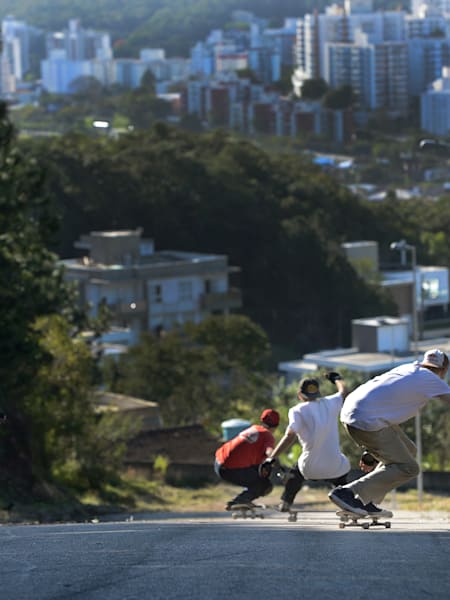Skateboarding
If you don't know much about skateboards or longboards, it may be tricky to tell the difference between them. Believe it or not, both boards have entirely different uses. When picking which would be best for you to ride, think about the main reason you want one: do you want to shred half-pipes or fly downhill? We'll explore the differences between them to help settle the skateboard vs. longboard debate.

3 min
This is how you shred the Alps in the summer
Watch these downhill longboarders shred tarmac in the Italian Alps.
01
Origins of Skateboards and Longboards
What is a Longboard?
To really understand the difference between a longboard and skateboard, let's dive into their history. Surfers in the early 1950s loved the feeling of catching waves so much that they wanted this same experience on land during flat days. After grabbing a wooden plank, cutting a board out of it, and sticking some wheels underneath, the skateboard was born. When skateboarders realized these boards were too huge and flat to nail tricks on, they made them smaller.
By the 1990s, surfers realized the board was way too small to cruise on and didn't really ride like a surfboard anymore. They tweaked the design and size of the skateboard once again to become what we now know of as a longboard.
Channel your inner skater. Listen to Zion Wright's skating playlist.
02
Five Differences Between a Longboard and a Skateboard
Here are the key differences between a longboard and a skateboard:
1. Shape and Size
If you put a longboard and skateboard side by side, you'll notice how flat the nose and tail of the longboard are. On a skateboard, you'll see more of a curve on its nose and tail to make it easier to land tricks and flips.
It should be no surprise that longboards are, of course, longer. They can be as long as 59 inches, while the typical skateboard is around 36 inches. Here's where it gets confusing: longboards also come in sizes as small as 28 inches long. If the length trips you up, just remember the key difference between the two is that longboards are flat and skateboards curve. So, if you see a flat, shorter board, it's probably just a short longboard.
2. Deck Flexibility
For any new skaters out there, the deck is the base of your board. If your goal is to learn new tricks, you want your board to be thinner, meaning it'll have flex. The flex of your board is the stiffness of it. You don't want the flex to be too soft unless you're engaging in mellow cruising. For tricks, you want your flexibility to be either soft or medium, which gives you some stability and a spring-like feel to make jumps easier to nail.
Many longboards are built to gain maximum speed as you race downhill. To keep you steady, longboards usually have thicker decks with low flex to support you during the ride.
3. Trucks and Wheels
Obviously, both skateboards and longboards have wheels attached, but the base that's attaching them is called the truck. It looks and operates differently for both boards. On a skateboard, the trucks are rigid and narrower, making it easier to grind and land tricks of your choice. They're also the same size as the maximum width of the skateboard's deck.
Longboards have a more flexible truck to give you a smoother ride, which is perfect for longboarders who want to cruise for long distances or race downhill. Longboards also hold wider trucks that usually measure around 150 millimeters to 180 millimeters.
For faster and smoother rides, the wheels of a longboard are large and soft. Skateboards have smaller and harder wheels to make it easier to shred rails, ledges, and gaps. If you plan to just cruise on your board, softer wheels give a smoother and more coordinated ride.
4. Balance
If your goal is to learn and master new tricks but you've never stepped foot on a skateboard, try a longboard first. Since they're larger and more stable, they're easier to balance on. Once you get more confident on a longboard, transition to a skateboard, and teach yourself how to balance better on a smaller board.
5. Speed and Tricks
If you're still having a tough time deciding which board to go for, ask yourself why you're riding. Do you want to perform impressive tricks or zoom by at maximum speeds?
Skateboards are perfect for riders who:
- Want to learn new tricks
- Grind rails
- Skate mini ramps
- Master kickflips
- Conquer ollies
Riders with longboards usually enjoy:
- A more stable riding experience
- Cruising with friends
- Bombing hills
- Riding the board to the beach
- Using their board to get around town
If you want to cruise or race friends, pick up a longboard and get skating. To explore some of the most legendary skate parks, go with a skateboard. And if you're completely new to skateboarding, get used to the balance and ride on a longboard first, then try out a skateboard. Once you get the hang of it, you'll be showing off your new tricks or beating friends at downhill races in no time.





